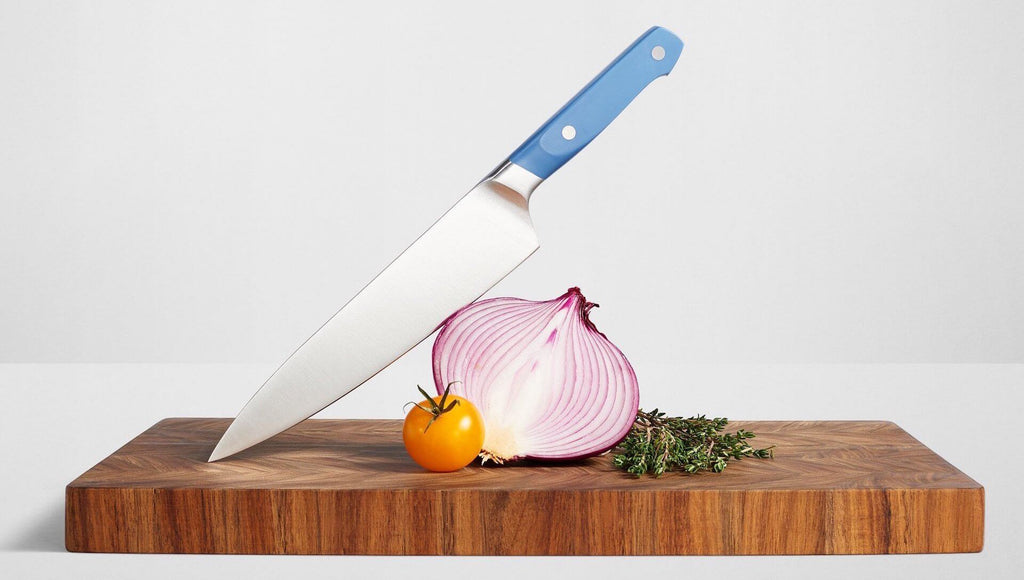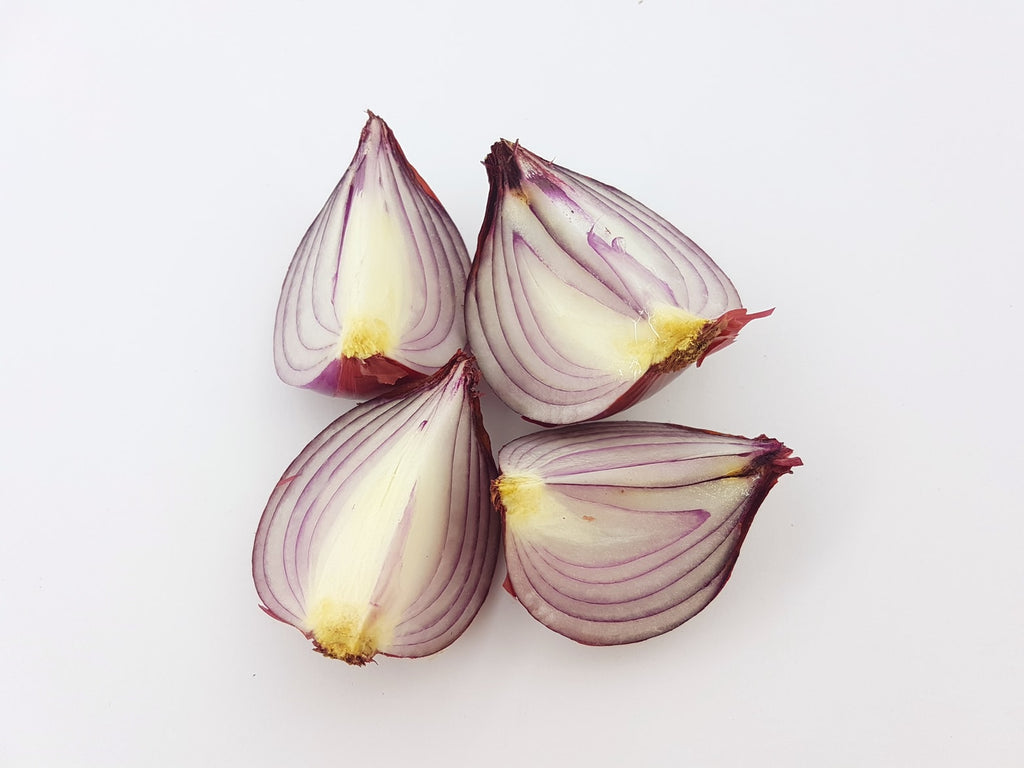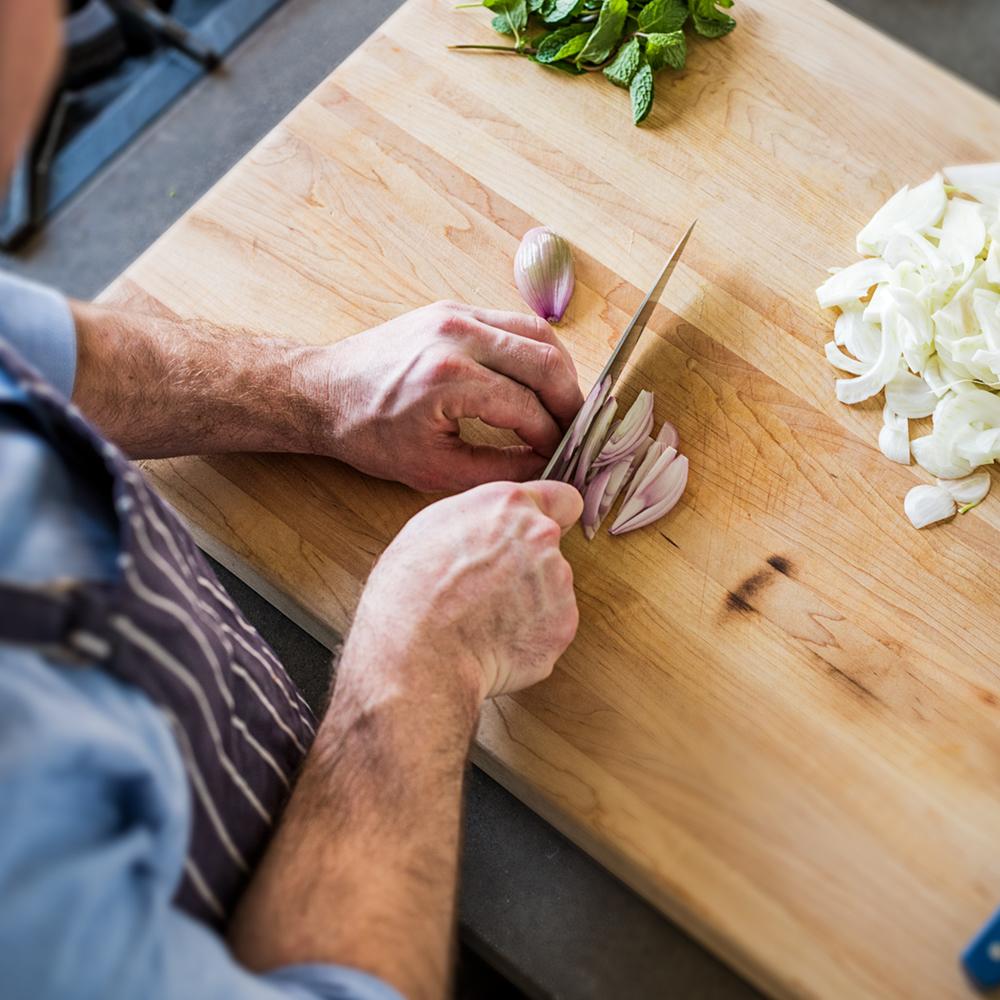How to Cut An Onion Without Crying: The Tried and Tested Ways
 To prepare an onion without crying, it’s important to have a well-sharpened knife in order to cut quickly and efficiently.
To prepare an onion without crying, it’s important to have a well-sharpened knife in order to cut quickly and efficiently.
- Onions contain a chemical compound that releases into the air and causes our eyes to water.
- Using a sharp knife creates cleaner slices and causes less of the compound to spread through the air.
- Cutting into a chilled onion is known to produce fewer tears than one that’s room temperature.
You’ve been cooking at home more often and are pretty proud of how your knife cutting skills have been coming along. Minced garlic? Sure. Diced tomatoes? Easy. Chopped onions? Still working on it.
Onions are still one of the trickiest ingredients to cut — not for their shape or tough composition, but for their ability to make nearly everyone’s eyes water. A single crunchy, raw onion can bring the most seasoned chef to tears.
Now, this wouldn’t be a problem if onions weren’t a staple ingredient. But they are. And to enjoy the mild bite of a pico de gallo or crunchy sweetness of an onion ring, you need to learn how to cut onions without crying.
Why Onions Make You Cry
It helps to first understand exactly why onions cause tears to well up.
Onions contain both sulfur compounds (which creates their pungent flavor) and an enzyme called synthase. As soon as an onion is sliced, the two elements form a chemical compound called syn-propanethial S-oxide. This is released into the air in the form of gas, which irritates the lacrimal glands in our eyes and causes them to water.
Armed with this knowledge, it’s now easier to find ways to cut onions without having to shed a tear.
Preparing Yourself to Cut an Onion
 Sweeter onions, like red onions or Vidalia onions, are less likely to cause tears, compared to more pungent white or yellow onions.
Sweeter onions, like red onions or Vidalia onions, are less likely to cause tears, compared to more pungent white or yellow onions.
There are two ways to minimize crying when cutting onions — reducing the amount of gas that’s released, and keeping as much gas as possible from coming into contact with our eyes.
To reduce the amount of gas released, we need to do as little damage to the onion as possible. The fewer cell walls broken when working with onions, the less gas comes out to cause tears.
Using a sharp knife is the best way to do the least amount of damage to an onion. A sharp knife easily slices through the onion, rather than a dull knife, which basically crushes the flesh and causes the tear-jerking gas to spread in the air.
Generally speaking, when cutting any ingredient, it's best to make sure you have a sharp, good quality knife in hand. A chef’s knife, which ranges from 8-12-inches in blade length, or a utility knife, at 4-7-inches, are perfect for many kitchen cutting tasks. For smaller onions, you can also use a sharp paring knife with a blade between 2-4-inches. A paring knife is also ideal for peeling, removing bruised spots, and other detailed work.
No matter which knife you choose, test if the blade is sharp enough by slicing into a ripe tomato or sheet of paper. If the blade slices cleanly through, it’s ready to cut some onions. If it doesn’t or if it produces a jagged cut, the blade needs to be honed or sharpened first.
You may find that some types of onions can cause your eyes to sting more than others. The general rule is the more pungent the onion, the higher the concentration of syn-propanethial-S-oxide. For example, some say they’re more sensitive to white and yellow onions than sweeter varieties, like red or Vidalia onions.
Once you have your onions, store them at cold temperatures. While chilling the onions isn’t common practice (in markets, we see them placed in baskets or bins), a cold onion releases gas at a slower rate compared to a room temperature onion — without affecting the taste.
For easier onion chopping, start storing them in the fridge or pop them in the freezer for about 10-15 minutes before you’re ready to prep.
How to Cut an Onion Without Crying
 Keeping an onion’s cut side down on the cutting board helps prevent the irritant gas from coming into contact with your eyes.
Keeping an onion’s cut side down on the cutting board helps prevent the irritant gas from coming into contact with your eyes.
Now it's time to start cutting. The idea is to prevent as much of the irritant gas as possible from entering our eyes. Although a few sources promote easy tricks, like chewing gum, putting a piece of bread in your mouth, or cutting onions under running water, these are not proven to work (and can even be dangerous).
The following are the best tried-and-tested practices to successfully cut an onion without crying.
With a sharp knife, start by cutting off the stem end of the whole onion, where the onion skin bunches together. Try to leave the root end intact and only remove the skin from the section of the onion you’re slicing. According to The National Onion Association, “the root end has the highest concentration of sulphuric compounds that make your eyes tear.”
As you cut, it’s best to cover or move the exposed parts of the onion. For example, after slicing the onion in half down the middle, from root to stem end, place the halves down on the cutting board with the flat side down. This not only helps prevent the gas from leaking into the air, it also puts the onion in a safe, ready cutting position, and prevents it from rolling away.
Next, remove the peel from one half of the onion. Start slicing lengthwise to the desired thickness, from the cut end of the onion just until you reach the root, without completely cutting through. Slicing this way first cuts less of the onion’s cellular structure and releases less gas.
When you’ve sliced all the way through the half, simply chop off the root end for sliced onions. For diced onions, use your hand or fingers to hold the onion half firmly in place, and slice through laterally, from cut end to the root, once or twice, depending on the thickness of the onion. Finally, chop the onion, starting from the top again, this time crosswise. This will leave you with a pile of neatly diced onions.
To cut onion rings, cut off the stem end and remove the entire peel. Cut a thin slice off one of the edges and place it on the cutting board to prevent the onion from rolling around. Then continue to cut crosswise at the desired thickness, starting from the stem end all the way to the root end.
Make sure to place all cut onions in a bowl and move it to another space in your kitchen. Cutting onions efficiently will make the entire process easier, quicker, and less likely to produce a lot of tears.
To take care of any gas that does get into the air, turn on your range hood and cut close to the area. If there’s no comfortable position, work near an open window or turn on a fan and face it in your direction as you chop. The exhaust or fan will help blow the gas away from your eyes.
Another tip is to simply save onions for last. By chopping all your other ingredients first, you effectively lessen the time you spend in the kitchen exposed to the irritant gas.
Of course, putting on a pair of air-tight goggles is a good guarantee that nothing will get into your eyes. However, it’s also the least comfortable, least convenient method. And if you stick to the above advice, it’s unlikely that you’ll need to resort to wearing your swim gear while you cook.
Taking the Shortcut
With the right tools and a few simple switches, you can easily turn a tearful experience into an everyday part of your meal prep. The next time a dish calls for dicing onions, all you need is a good sharp knife, a chilled onion, and the right cutting method to properly cut an onion without shedding a tear.










